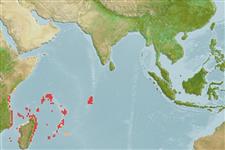>
Eupercaria/misc (Various families in series Eupercaria) >
Nemipteridae (Threadfin breams, Whiptail breams)
Etymology: Scolopsis: Name from the Greek masculine noun 'skolos' meaning 'thorn' and suffix '-opsis' (from Greek feminine n. 'opsis' meaning 'aspect', 'appearance') meaning ‘thorny appearance’ presumably referring to 'les dentelures de la préopercule, en ont aussi, et même d'épineuses, aux sous-orbitaires' mentioned by Cuvier (1814) in his designation of the genus. Name ending in -'opsis' are treated as feminine according to ICZN 1999: Article 30.1.2 (Ref. 130620).
More on author: Cuvier.
Environment: milieu / climate zone / profondeur / distribution range
Écologie
marin récifal; profondeur 5 - 20 m (Ref. 9710). Tropical; 1°S - 23°S, 39°E - 75°E (Ref. 3810)
Western Indian Ocean: including the Seychelles, Chagos Archipelago, Mauritius, Réunion and Madagascar.
Taille / Poids / Âge
Maturité: Lm ? range ? - ? cm
Max length : 26.0 cm TL mâle / non sexé; (Ref. 9710); common length : 17.0 cm SL mâle / non sexé; (Ref. 3810)
Épines dorsales (Total) : 10; Rayons mous dorsaux (Total) : 9; Épines anales: 3; Rayons mous anaux: 7. Head scales reaching to between anterior margin of eyes and posterior nostrils. Lower limb of preopercle naked. Antrorse (forward-directed) suborbital spine absent. Pelvic fins long, reaching to or just beyond level of anus. Upper lobe of caudal fin slightly longer than lower lobe in larger specimens. Axillary scale present. Color: Upper body blue or olive green, white below. A yellow stripe from top of snout, through upper part of eye and arching on back to upper part of caudal peduncle. A narrow yellow stripe from top of head running along base of dorsal fin, this stripe disappearing with age. Juveniles blue on upper half of body, white below.
Body shape (shape guide): fusiform / normal; Cross section: oval.
Inhabits sandy bottoms close to coral reefs. Occurs in small groups. Juveniles are solitary (Ref. 9710).
Life cycle and mating behavior
Maturité | Reproduction | Frai | Œufs | Fécondité | Larves
Russell, B.C., 1990. FAO Species Catalogue. Vol. 12. Nemipterid fishes of the world. (Threadfin breams, whiptail breams, monocle breams, dwarf monocle breams, and coral breams). Family Nemipteridae. An annotated and illustrated catalogue of nemipterid species known to date. FAO Fish. Synop. 125(12):149p. Rome: FAO. (Ref. 3810)
Statut dans la liste rouge de l'IUCN (Ref. 130435: Version 2025-1)
Menace pour l'homme
Harmless
Utilisations par l'homme
Pêcheries: pêcheries vivrières
Outils
Articles particuliers
Télécharger en XML
Sources Internet
Estimates based on models
Preferred temperature (Réf.
123201): 25.7 - 28.2, mean 27.5 °C (based on 219 cells).
Phylogenetic diversity index (Réf.
82804): PD
50 = 0.5000 [Uniqueness, from 0.5 = low to 2.0 = high].
Bayesian length-weight: a=0.01660 (0.00747 - 0.03689), b=2.98 (2.81 - 3.15), in cm total length, based on LWR estimates for this Genus-body shape (Ref.
93245).
Niveau trophique (Réf.
69278): 3.3 ±0.39 se; based on food items.
Résilience (Réf.
120179): Haut, temps minimum de doublement de population inférieur à 15 mois (Preliminary K or Fecundity.).
Fishing Vulnerability (Ref.
59153): Low vulnerability (16 of 100).
🛈
Nutrients (Ref.
124155): Calcium = 64.5 [40.9, 132.2] mg/100g; Iron = 0.692 [0.339, 1.632] mg/100g; Protein = 19 [17, 21] %; Omega3 = 0.137 [0.082, 0.228] g/100g; Selenium = 25.4 [15.0, 46.2] μg/100g; VitaminA = 75 [20, 222] μg/100g; Zinc = 1.39 [0.97, 2.05] mg/100g (wet weight);
